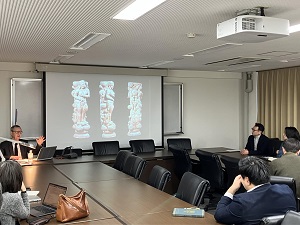News
東文研セミナー "Before The Buddha: The Beginnings of Buddhist Imagery in Early India, 200 BCE - 400 CE" が開催されました
報告
John Guy氏(メトロポリタン美術館南アジア・東南アジア上席学芸員)の講演、"Before The Buddha: The Beginnings of Buddhist Imagery in Early India, 200 BCE - 400 CE" は、約20名の参加者があった。初期仏教美術に関する画期的な内容であり、講演後も活発な質疑が続いた。
当日の様子
開催情報
日時: 2024年1月9日(火) 15時00分〜16時30分
会場: 東京大学東洋文化研究所第一会議室(3階)
発表者: John Guy博士(メトロポリタン美術館南アジア・東南アジア上席学芸員)
題目: Before The Buddha: The Beginnings of Buddhist Imagery in Early India, 200 BCE - 400 CE
司会:馬場紀寿(東京大学東洋文化研究所教授)
使用言語:英語
要旨:
Before the appearance of the Buddha image some 500 or so years after his lifetime, the visual repertoire used to teach the Buddha’s message was one rich in its celebration of the natural world, presided over by its personified spirits, the yakshas and nagas. This talk – and the exhibition Tree & Serpent that it accompanies - explores the earliest recorded cultural landscape of Buddhist India, that of monastic Buddhism, and the cult of relics that was central to Buddhist worship. The monumental tumuli that were built to house the relics - the stupa – became the central object of adornment, embodying the first Buddhist art in its décor.
The focus here shifts away from Greater Magadha in north India where the Buddha was born, preached and died, south to the Deccan - Dashinapatha - where he never ventured in person, but which was enlivened by the presence of his relics from an early date. Much of the earliest Buddhist art to have survived belongs to the Deccan, witnessed by that of Bharhut, Sanchi, Ajanta and Amaravati. The earliest drum panels, murals, enclosure railings (vedika) and gateways (toranas) preserved at these monuments stand unrivalled at the dawn of Buddhist art.
A secondary theme of this lecture explores this rich archaeological and artistic legacy which, when read alongside the canonical and narrative literature of early Buddhism, paints a vision of a colorful and fragrant world where the monastery served not only as a sanctuary for mendicants, but also as a place of beauty and quietude intended to attract lay followers. Both the literature and art are rich in sensory imagery, in apparent contradiction of the vouched goals of ascetism and sensory denial at the heart of the Buddha’s teachings. Was this imagery simply a literary and visual foil against which to set the challenges of the Buddhist quest, or did it represent a more profound ambivalence in the reality of early lived Buddhist – one where economic viability was dependent on the support of a prosperous lay community, attracted to a more worldly vision of a Buddhist paradise?
John Guy is the Senior Curator of the Arts of South and Southeast Asia at The Metropolitan Museum of Art, New York, and an elected Fellow of the Society of Antiquaries London (2003) and of the American Academy of Arts and Sciences (2016). Prior to that he served for 22 years as senior curator of Indian art at the Victoria and Albert Museum, London. He has curated numerous international art exhibitions and published widely, including Oriental Trade Ceramics in South-East Asia. Ninth to Sixteenth Centuries (OUP, 1986), Ceramic Traditions of South-East Asia (OUP, 1989), Indian Art and Connoisseurship (IGNCA, 1995), South East Asia and China: Art, Commerce and Interaction (SOAS, ed. 1996), Vietnamese Ceramics. A Separate Tradition (Paragon, co-author 1997), Woven Cargoes. Indian Textiles in the East (T&H, 1998), Indian Temple Sculpture (V&A, 2007), Wonder of the Age. Master Painters of India (Met, co-author 2011), Interwoven Globe. The Worldwide Textile Trade (Met, co-author 2013), Lost Kingdoms. Hindu-Buddhist Sculpture of Early Southeast Asia (Met, 2014), Art & Independence. Y.G. Srimati and the Indian Style (Mapin, 2019) and most recently Tree & Serpent. Early Buddhist Art in India (Met, 2023).
登録種別:研究活動記録
登録日時:ThuJan1110:18:262024
登録者 :馬場・多田
掲載期間:20240112 - 20240411
当日期間:20240109 - 20240109



